In 1818, a coppersmith named William Heiss built a four-story home on the banks of the Delaware River in Bristol, Pa. Captain Joseph Hutchinson bought the home in 1934, then expanded it. William Grundy, a successful wool entrepreneur, purchased the property in 1884. He and his wife, Mary, further expanded and remodeled the home and raised their two children, Joseph and Margaret, along the banks of the placid river.
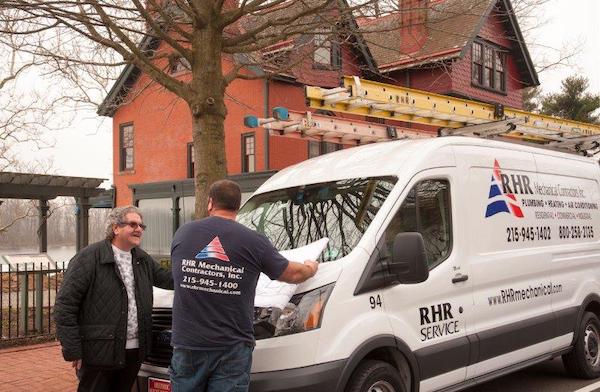
Ray Perotti, owner of RHR Mechanical Contractors, Inc., and his son, Ray Perotti Jr., look over the HVAC design for the museum installation.
Joseph Grundy grew up to become a successful business icon and in 1929 was appointed to the U.S. Senate. He and his sister Margaret were philanthropists, and much of the development in the Bristol area is owed to their generosity and community-focused mindset. Margaret founded a library adjacent to the family mansion, which was replaced with a new one following the terms of Joseph’s will after his death in 1961.
Today, the home museum and library are operated by the Grundy Foundation, each named in Margaret’s honor, and stand for the Grundy family’s values: love of their hometown, civic participation, devotion to family, respect for hard work and commitment to education. By establishing the Grundy Foundation, Senator Grundy wanted to ensure the ongoing well-being of the residents of Bristol Borough and its surroundings in Bucks County, Pa.
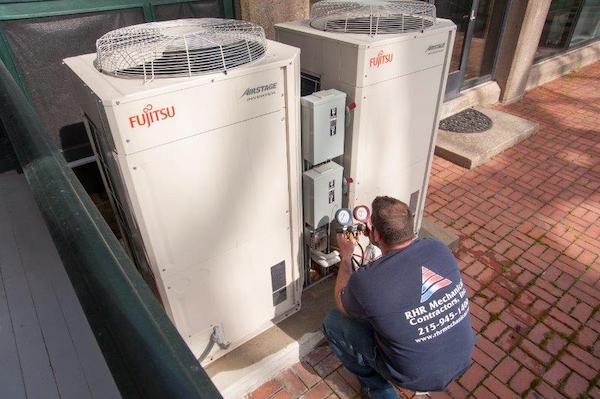
Foundation assets have assured for proper care of the 5,000-sq.-ft. museum, and in 2019, discussions about adding air conditioning and upgrading the heating system began.
“As part of a three-year renovation of the structure, AC and improved heating were major additions that the foundation deemed necessary,” said Geoff Webster, museum curator. “We are directly on the river, so it’s very muggy in summer. We weren’t able to open the windows, and the museum grew incredibly hot. Full tours typically take an hour, but our summer tours were limited to 20 minutes because staff and visitors simply couldn’t tolerate the heat. The humidity also isn’t good for the collections, artifacts, and antique woodwork.”
Local talent
Ray Perotti, a lifelong resident of the Bristol area, lives just down the street from the Grundy Museum, and is well known in the community. He owns RHR Mechanical Contractors, Inc. The 25-person commercial/industrial firm is known for their work on large, challenging projects between Wilmington, DE, and New York City. They’re trusted by a wide range of commercial firms, schools, and occasional high-end residential customers. In 2019, when they were contacted by the Grundy Foundation for a design-build solution, RHR had installed many mini-split systems, but had installed only a few VRF systems.
 “I knew that either Fujitsu Halcyon mini-splits or a VRF were going to be the solution on this project, due to the challenges of addressing the needs of the building without detracting from the facility’s historical nature,” said Perotti. “My concern with mini-splits—later confirmed—would be the high number of outdoor units needed. As for the VRF option, that left us with some uncertainty about the brand of system best-suited to the task. The level of support we were offered by Ed Peterson, technical service advisor at Johnstone Supply, and Jim McBride, at Harry Eklof, made it an easy decision.”
“I knew that either Fujitsu Halcyon mini-splits or a VRF were going to be the solution on this project, due to the challenges of addressing the needs of the building without detracting from the facility’s historical nature,” said Perotti. “My concern with mini-splits—later confirmed—would be the high number of outdoor units needed. As for the VRF option, that left us with some uncertainty about the brand of system best-suited to the task. The level of support we were offered by Ed Peterson, technical service advisor at Johnstone Supply, and Jim McBride, at Harry Eklof, made it an easy decision.”
Peterson and McBride toured the facility with Perotti, spoke with staff at the museum, and designed a Fujitsu Airstage V2 VRF system that would meet all of the needs and ease any concerns about maintaining the building’s historic integrity. Even thermostats were to be hidden. Being RHR Mechanical Contractors’ first Airstage VRF installation, Perotti sent two lead technicians to Johnstone Supply for VRF training.
A solution for sensitive space
Meetings at the museum resulted in a design that required a lot of creativity. There was some ductwork already available; tin, from the 1960s. This had either been abandoned or was still currently in use for hot water coils connected to the building’s oil boiler. Without the option to add new ductwork, RHR cleaned and camera’d the ductwork before determining that it could be retrofitted with new VRF air handlers.
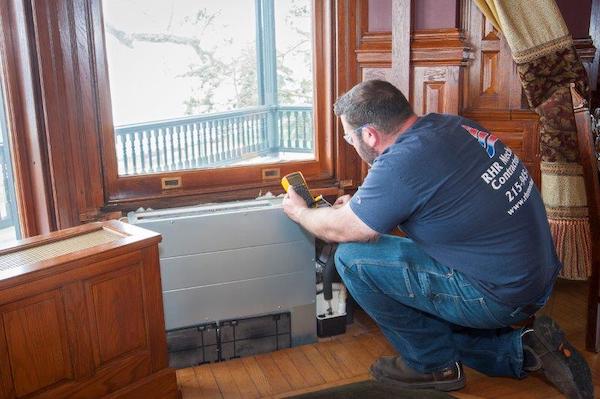
“Building new soffit to hide ductwork wasn’t acceptable to the Board of Directors,” said Webster. “Also, almost every interior wall in the museum was once a brick exterior wall, so new penetrations had to be kept at an absolute minimum.”
Most of the museum (minus the two basements and the third story attic) could be served by the old ductwork, with one zone upstairs and one downstairs. Even the old brass registers were polished and re-installed. Two Airstage air handlers in the basement provide the heating and cooling, meeting the need with one four-ton vertical and one four-ton horizontal unit.
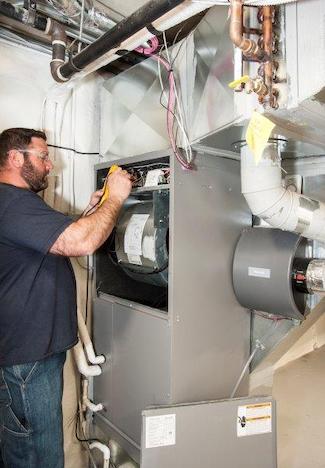 The only space on the first floor that doesn’t receive sufficient airflow from the ductwork is the dining room. Here, a small horizontal air handler is hidden inside an original radiator cabinet, which needed to be carefully disassembled and rebuilt. Instead of brazing refrigerant lines, ZoomLock flame-free fittings were used.
The only space on the first floor that doesn’t receive sufficient airflow from the ductwork is the dining room. Here, a small horizontal air handler is hidden inside an original radiator cabinet, which needed to be carefully disassembled and rebuilt. Instead of brazing refrigerant lines, ZoomLock flame-free fittings were used.
“The slim duct unit that was used within the wood cabinet could be mounted vertically without the need for a riser,” said Peterson. “The competitor’s unit required a riser, meaning it wouldn’t have fit the dimensions of the old cabinet.”
There were spaces in the building where maintaining historical integrity wasn’t a key concern. The 1,300 square-foot caretaker’s quarters in the daylight basement received three wall-hung units, an office in the attic now has a small horizontal air handler, and two air handlers in the attic connect to new ductwork. This space was conditioned simply to protect items that are kept in storage. In all, the museum now has eight zones of heating and cooling.
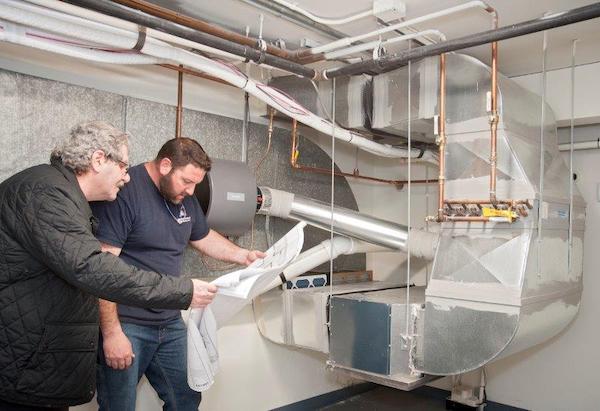
“The compact footprint of Fujitsu’s Airstage systems was a big advantage on this project,” said Peterson. “We were very limited by where we could set the condensing units. We were able to install them on a small porch between the museum and the library, out of sight from the road and from visitors.”
Physical size was only half the equation. Per code, the occupied space of the museum could only be served by a single system containing 26 pounds of refrigerant per 1,000 cubic feet. Peterson and McBride suggested installing one six-ton and one eight-ton system instead of a single 14-ton unit. This not only split the refrigerant charge between two systems, but also provides a level of redundancy for the museum.
Constant humidity and simple control
“On the control side of the project, there were two things that the foundation was adamant about,” explained Peterson. First, the humidity had to remain constant year ‘round, and would require constant monitoring. They actually have to report humidity levels to the Board of Directors. Second, they wanted a very user-friendly control platform. This was made slightly more complicated because of the firewalls within the system that communicates between the museum and the library, but we had a solution.”
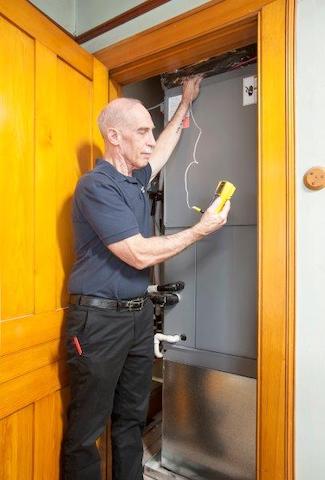 If not for the security measures in the existing communication system, the Fujitsu Airstage controls would’ve been sufficient to provide the data collection and logging the museum required. With that added complexity, Peterson suggested using a Honeywell RedLINK system, coupled to the Airstage controls via Fujitsu’s third party adapter.
If not for the security measures in the existing communication system, the Fujitsu Airstage controls would’ve been sufficient to provide the data collection and logging the museum required. With that added complexity, Peterson suggested using a Honeywell RedLINK system, coupled to the Airstage controls via Fujitsu’s third party adapter.
This solution gathers information from the 20 sensors hidden throughout the museum, stores the data, and provides simple access for museum personnel.
Summertime humidity is controlled by the AC function of the VRF system. During the dry winter, a Honeywell humidifier is used on the first floor and second floor duct systems. Because of concern about a leak, the attic system does not feature a humidifier. The use of the humidifiers protects paintings, wooden fixtures and trim, tapestries, etc.
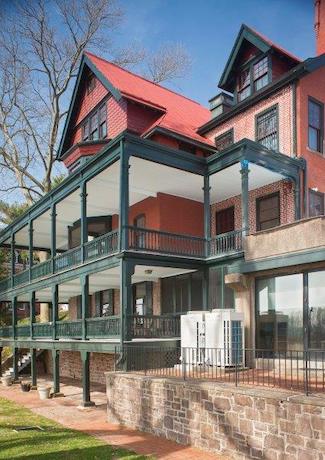 From first contact to commissioning, the project took over two years to complete. The sweeping museum renovation that was ongoing in 2019 extended the timeline considerably, as did the COVID lockdowns. A full year was lost to health precautions. The system was operational for a year before final commissioning.
From first contact to commissioning, the project took over two years to complete. The sweeping museum renovation that was ongoing in 2019 extended the timeline considerably, as did the COVID lockdowns. A full year was lost to health precautions. The system was operational for a year before final commissioning.
“This is one of the oldest buildings in the area,” said Peterson. “Marrying it with cutting edge technology, invisibly, was gratifying. We’ve proven that we can think outside the box to provide an extremely comfortable, efficient system, and museum personnel are thrilled.”



